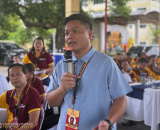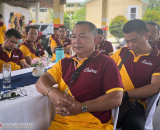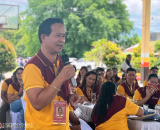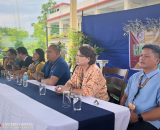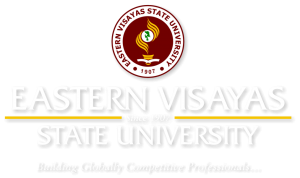Ormoc City, Leyte – In the last leg of the Harampang sessions, the university’s top management, led by the President, Dr. Dennis C. de Paz, actively engaged in discussions with the EVSU Ormoc campus’ community on Thursday, September 5, at the campus’ covered court.
Graced by faculty, non-teaching staff, and student representatives, the key officials were warmly welcomed with a festive ambience initiated by the students, in conjunction with the celebration of their USWAG 2024.
The concerns raised centered on the fourfold function of the employees, continuing professional development, among other things.
For one, the adherence to the school uniform served as the introductory concern, setting the tone for interactive dialogue and friendly engagement. The president underscored the students’ welfare and preference regarding the wearing of school uniform. He cited some universities abroad that do not follow strict uniform policies, and yet their students perform best in the academe. “What is important is students are performing well in their respective classes,” mentioned de Paz. However, he went on to say that it is high time for the administration to revisit and revise the policy on haircut and uniform in such a way that it may be favorable to the students while still adhering to the principles of formality, considering EVSU’s repute as an academic institution.
Dr. Jeffry Ocay, the Ormoc campus’ current Campus Director, elucidated the faculty’s concern as regards the ‘de-loading’ of their workload, paving the way to the intensification of research work—the lifeblood of the university. Further, it was made clear that such ‘de-loading’ will be monitored through the submission of a Certificate of Verification to the research office at the end of every semester. Dr. Analyn C. Españo, the Vice President for Research & Extension, and Development Office, encouraged faculty, staff, and students to conduct research, thereby contributing to the vibrant body of knowledge. “We encourage research-based extension programs in favor of the faculty doing much extension work,” VP Españo stated. In addition, research work can be done not only by those faculty with high academic ranks, but also by the instructors and assistant professors who are advancing their scholastic portfolio as they practice their teaching profession. To smoothen the research-conducting process, the administration also encouraged collaboration and mentoring, reechoing that research is the very essence of the university.
As the faculty conveyed academic and administrative issues, the student leader also brought to light problems pertaining to the full face-to-face conduct of classes. He cited the current situation in which the EVSU system is revolutionizing its operations, with the SMART university project being a top priority of the administration. With this, he raised problems about the lack of classrooms. EVSU’s president aptly responded that since the traditional classrooms are still under renovation being converted to e-classrooms, some of the courses may be conducted online, with the knowledge and monitoring of the respective heads of the department. “GenEd subject teachers are encouraged to conduct online (classes),” he added. This issue is linked to a much deeper problem of the disproportionate enrolment data per semester that is beyond the capacity of what the university can accommodate. Dr. de Paz enumerated initiatives to mitigate these concerns: merge small-sized classrooms, limit the number of students to be admitted in the campus, CHED-priority programs may have two (2) sections, but non-CHED priority programs may limit the number of sections and students.
Being innovative themselves through knowledge transfer, the faculty members strive to advance their skills and knowledge through creative work. For instance, a faculty member under the Bachelor of Science in Information Technology (BSIT) program inquired whether a self-made mobile application may be credited for a copyright, which would further enhance his reputation as an expert on the field. To address this question, Vice President Españo rejoined that this can be considered an output under the creative work category and can be processed for copyright as long as the application helps improve the operations in the university. This issue emanates from the possibility of earning a credit on the reclassification of the faculty members. Similarly, Dr. de Paz advised to review the guidelines for reclassification should there be concerns. “Study the guidelines; Always make the guidelines your bible…Creative work is given emphasis,” said Dr. de Paz.
As regards the Human Resource Office and the hiring of new employees, Dr. Ocay reported that they are 95% complete under Revised Organization and Staffing Standards (ROSS). This is intended to help reduce and manage the university’s operating costs and to lessen the rigor of faculty members with administrative designations; however, some departments admitted to the scarcity of qualified faculty, which is required during the application for Certificate of Program Compliance (COPC) and for the AACCUP accreditation, not to mention the lack of facilities and laboratories which are highly sought after by the Commission on Higer Education. Dr. de Paz positively responded that with the SMART university scheme and the solicited funds coming from the government officials and party-list, compliance is expected to be achieved.
Dr.de Paz also weighed in on the following concerns, to wit: efficient use of budget, synergistic planning officers’ project in adherence to the LUDIP blueprint, human resource expediting of hiring qualified faculty and personnel,
Meanwhile, Dr. Ocay took the opportunity to highlight the importance of the Harampang in an organization. “This is one of the opportunities for us to strengthen the bond that binds us together as one family,” he stated.
The Harampang 2024 came into culmination with meaningful interaction, synergistic bond, forward-thinking initiatives, and clear vision that will lead the university to greater heights.
Written by: J Genobiagon | UMDC
Edited by: JS Beleña | UMDC





